Standards Worldwide
Standards Worldwide
Phone +49 30 58885700-07

Standard [CURRENT]
ASTM E 399:2024
Standard Test Method for Linear-Elastic Plane-Strain Fracture Toughness of Metallic Materials
- Publication date
- 2024
- Original language
- English
- Pages
- 40
- Publication date
- 2024
- Original language
- English
- Pages
- 40
- DOI
- https://dx.doi.org/10.1520/E0399-24
Product information on this site:
Quick delivery via download or delivery service
Buy securely with a credit card or pay upon receipt of invoice
All transactions are encrypted
Short description
1.1 This test method covers the determination of fracture toughness ( KIc and optionally KIsi ) of metallic materials under predominantly linear-elastic, plane-strain conditions using fatigue precracked specimens having a thickness of 1.6 mm (0.063 in.) or greater 2 subjected to slowly, or in special (elective) cases rapidly, increasing crack-displacement force. Details of test apparatus, specimen configuration, and experimental procedure are given in the annexes. Two procedures are outlined for using the experimental data to calculate fracture toughness values: 1.1.1 The KIc test procedure is described in the main body of this test standard and is a mandatory part of the testing and results reporting procedure for this test method. The KIc test procedure is based on crack growth of up to 2 % percent of the specimen width. This can lead to a specimen size dependent rising fracture toughness resistance curve, with larger specimens producing higher fracture toughness results. 1.1.2 The KIsi test procedure is described in Appendix X1 and is an optional part of this test method. The KIsi test procedure is based on a fixed amount of crack extension of 0.5 mm, and as a result, KIsi is less sensitive to specimen size than KIc . This less size-sensitive fracture toughness, KIsi , is called size-insensitive throughout this test method. Appendix X1 contains an optional procedure for reinterpreting the force-displacement test record recorded as part of this test method to calculate the additional fracture toughness value, KIsi . Note 1: Plane-strain fracture toughness tests of materials thinner than 1.6 mm (0.063 in.) that are sufficiently brittle (see 7.1 ) can be made using other types of specimens ( 1 ) . 3 There is no standard test method for such thin materials. 1.2 This test method is divided into two parts. The first part gives general recommendations and requirements for testing and includes specific requirements for the KIc test procedure. The second part consists of Annexes that give specific information on displacement gage and loading fixture design, special requirements for individual specimen configurations, and detailed procedures for fatigue precracking. Additional annexes are provided that give specific procedures for beryllium and rapid-force testing, and the KIsi test procedure, which provides an optional additional analysis procedure for the test data collected as part of the KIc test procedure. 1.3 General information and requirements common to all specimen configurations: Section Referenced Documents 2 Terminology 3 Stress-Intensity Factor 3.1.1 Plane-Strain Fracture Toughness 3.1.2 Crack Plane Orientation 3.1.4 Summary of Test Method 4 Significance and Use 5 Significance 5.1 Precautions 5.1.1 - 5.1.5 Practical Applications 5.2 Apparatus (see also 1.4 ) 6 Tension Machine 6.1 Fatigue Machine 6.2 Loading Fixtures 6.3 Displacement Gage, Measurement 6.4 Specimen Size, Configurations, and Preparation (see also 1.5 ) 7 Specimen Size Estimates 7.1 Standard and Alternative Specimen Configurations 7.2 Fatigue Crack Starter Notches 7.3.1 Fatigue Precracking (see also 1.6 ) 7.3.2 Crack Extension Beyond Starter Notch 7.3.2.2 General Procedure 8 Specimen Measurements Thickness 8.2.1 Width 8.2.2 Crack Size 8.2.3 Crack Plane Angle 8.2.4 Specimen Testing Loading Methods 8.3 Loading Rate 8.4 Test Record 8.5 Calculation and Interpretation of Results 9 Test Record Analysis 9.1 ...
ICS
77.040.10
DOI
https://dx.doi.org/10.1520/E0399-24
Also available in
Loading recommended items...
Loading recommended items...
Loading recommended items...
Loading recommended items...
